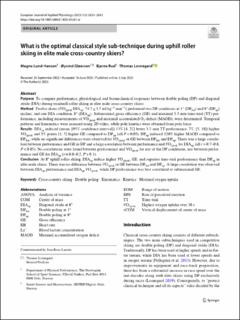| dc.contributor.author | Lund-Hansen, Magne | |
| dc.contributor.author | Gløersen, Øyvind | |
| dc.contributor.author | Rud, Bjarne | |
| dc.contributor.author | Losnegard, Thomas Johansen | |
| dc.date.accessioned | 2024-01-05T08:25:11Z | |
| dc.date.available | 2024-01-05T08:25:11Z | |
| dc.date.created | 2023-08-30T13:45:05Z | |
| dc.date.issued | 2023 | |
| dc.identifier.citation | European Journal of Applied Physiology. 2023, 123(12), Side 2833-2842. | en_US |
| dc.identifier.issn | 1439-6319 | |
| dc.identifier.uri | https://hdl.handle.net/11250/3110009 | |
| dc.description | This article is licensed under a Creative Commons Attribution 4.0 International License, which permits use, sharing, adaptation, distribution and reproduction in any medium or format, as long as you give appropriate credit to the original author(s) and the source, provide a link to the Creative Commons licence, and indicate if changes were made. The images or other third party material in this article are included in the article's Creative Commons licence, unless indicated otherwise in a credit line to the material. If material is not included in the article's Creative Commons licence and your intended use is not permitted by statutory regulation or exceeds the permitted use, you will need to obtain permission directly from the copyright holder. | en_US |
| dc.description.abstract | Purpose: To compare performance, physiological and biomechanical responses between double poling (DP) and diagonal stride (DIA) during treadmill roller skiing in elite male cross-country skiers.
Method: Twelve skiers (VO2peak DIAup; 74.7 ± 3.7 ml kg−1 min−1) performed two DP conditions at 1° (DPflat) and 8° (DPup) incline, and one DIA condition, 8° (DIAup). Submaximal gross efficiency (GE) and maximal 3.5 min time-trial (TT) performance, including measurements of VO2peak and maximal accumulated O2-deficit (MAOD), were determined. Temporal patterns and kinematics were assessed using 2D video, while pole kinetics were obtained from pole force.
Results: DIAup induced (mean, [95% confidence interval]) 13% [4, 22] better 3.5-min TT performance, 7%, [5, 10]) higher VO2peak and 3% points [1, 5] higher GE compared to DPup (all P < 0.05). DPup induced 120% higher MAOD compared to DPflat, while no significant differences were observed for VO2peak or GE between DPflat and DPup. There was a large correlation between performance and GE in DP and a large correlation between performance and VO2peak for DIAup (all r = 0.7–0.8, P < 0.05). No correlations were found between performance and VO2peak for any of the DP conditions, nor between performance and GE for DIAup (r = 0.0–0.2, P > 0.1).
Conclusion: At 8º uphill roller skiing, DIAup induce higher VO2peak, GE, and superior time-trial performance than DPup in elite male skiers. There was no difference between VO2peak or GE between DPflat and DPup. A large correlation was observed between DIAup performance and DIAup VO2peak, while DP performance was best correlated to submaximal GE. | en_US |
| dc.language.iso | eng | en_US |
| dc.subject | cross-country skiing | en_US |
| dc.subject | double poling | en_US |
| dc.subject | kinematics | en_US |
| dc.subject | kinetics | en_US |
| dc.subject | maximal oxygen uptake | en_US |
| dc.title | What is the optimal classical style sub-technique during uphill roller skiing in elite male cross-country skiers? | en_US |
| dc.type | Peer reviewed | en_US |
| dc.type | Journal article | en_US |
| dc.description.version | publishedVersion | en_US |
| dc.rights.holder | © The Author(s) 2023 | en_US |
| dc.source.pagenumber | 2833-2842 | en_US |
| dc.source.volume | 123 | en_US |
| dc.source.journal | European Journal of Applied Physiology | en_US |
| dc.source.issue | 12 | en_US |
| dc.identifier.doi | 10.1007/s00421-023-05261-w | |
| dc.identifier.cristin | 2170981 | |
| dc.description.localcode | Institutt for fysisk prestasjonsevne / Department of Physical Performance | en_US |
| cristin.ispublished | true | |
| cristin.fulltext | original | |
| cristin.qualitycode | 1 | |
